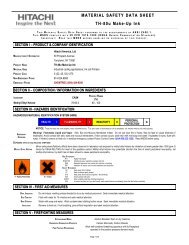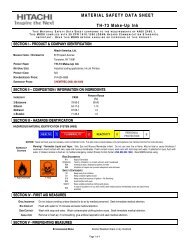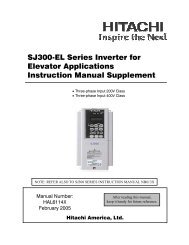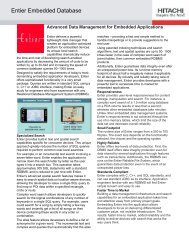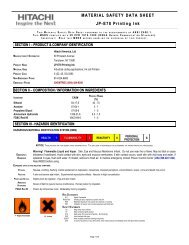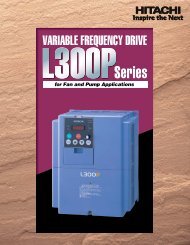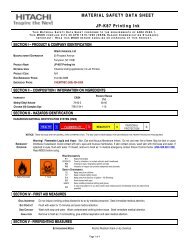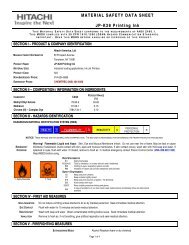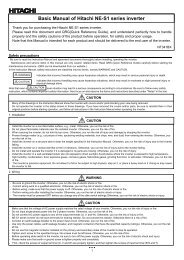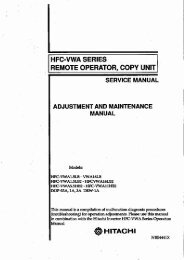SJ700-2 Instruction Manual NT204DX - Hitachi America, Ltd.
SJ700-2 Instruction Manual NT204DX - Hitachi America, Ltd.
SJ700-2 Instruction Manual NT204DX - Hitachi America, Ltd.
Create successful ePaper yourself
Turn your PDF publications into a flip-book with our unique Google optimized e-Paper software.
Chapter 4 Explanation of Functions<br />
When you specify the 02 RS485 communication for the PV source setting (A076), transfer data as<br />
described below.<br />
1) When the ASCII mode is selected (C078 = 00)<br />
Use the 01 command for data transfer. To transfer feedback data, set the most-significant byte of<br />
frequency data to "1".<br />
Example: When transmitting the frequency data specifying 5 Hz<br />
The data to be transmitted consists of six bytes, indicating a value 100 times as large as<br />
the set frequency value. → "000500"<br />
Change the most-significant byte to "1". → "100500"<br />
Convert the data to ASCII format. → "31 30 30 35 30 30"<br />
Note: In ASCII mode, the unit of setting is always frequency (Hz).<br />
2) When the Modbus RTU mode is selected (C078 = 01)<br />
Write the setting data (on the assumption that "10000" indicates 100%) to register address 0006h.<br />
Register<br />
Readable/writable<br />
Data<br />
Function name Function code<br />
Monitored data or setting<br />
No.<br />
(R/W)<br />
resolution<br />
0006h PID feedback - R/W 0 to 10000 0.01 [%]<br />
Note: This register is readable and writable. However, this register can be read only when Modbus<br />
RTU has been specified as the communication mode for PID feedback. It cannot be read with<br />
other settings.<br />
- When pulse train input is specified for PID feedback, the input pulse train frequency (Hz) is converted to a<br />
percentage (with maximum frequency corresponding to 100%) and fetched as the feedback.<br />
For the pulse train input frequency, see Section 4.3.21.<br />
(4) Feed forward selection<br />
- Select the terminal to be used for the feed forward signal through PID feed forward selection (A079).<br />
- Even if the terminal selected for the target or feedback data is also selected for the terminal by A079, the<br />
terminal functions according to the setting of A079.<br />
- Specifying the value to disable selection for A079 disables feed forward control.<br />
(5) Output of inverted PID deviation<br />
Some sensor characteristics may cause the polarity of the deviation of feedback data from the target value<br />
to be inconsistent with the inverter operation command. If the inconsistency occurs, specify "01" for<br />
function "A077" to invert the polarity of the deviation.<br />
Example: When controlling the compressor for a refrigerator<br />
Assume that the temperature and voltage specifications of the temperature sensor are -20°C to +100°C<br />
and 0 to 10 V and the target value is 0°C.<br />
If the current temperature is 10°C and the inverter is under the normal type of PID control, the inverter will<br />
reduces the output frequency because the feedback data is larger than the target value.<br />
→ In such a case, specify "01" for function "A077" to invert the feedback deviation. Then, the inverter will<br />
increase the output frequency.<br />
A077<br />
PID target value<br />
-1<br />
PID<br />
operation<br />
PID feedback data<br />
(6) Limitation on PID variation range<br />
You can limit the PID output to within a specific range with reference to the target value.<br />
To use the PID variation limit function, set the PID variation range (A078).<br />
(Set a value on the assumption that the maximum frequency corresponds to 100%.)<br />
The variation of PID output is limited within ±"value of A078" from the target value.<br />
(Setting "0.0" for the PID variation range [A078] disables the PID variation limit function.)<br />
This function is deactivated when 0.0 is set on A078.<br />
PID output (%)<br />
PID output range<br />
PID target value<br />
PID variation range (A078)<br />
PID variation range (A078)<br />
4 - 28<br />
Time (s)




